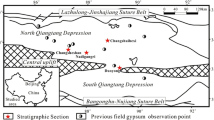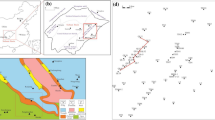Abstract
According to the recent chronostratigraphic division of Cambrian, the Cambrian strata in the Kelan section can be subdivided into seven third-order sequences (\(\hbox {DS}_{1}{-}\hbox {DS}_{7})\) based on cyclicity in sedimentary facies stacking patterns. The calcareous mudstone forming condensed section, micritic limestone comprising deep to middle ramp facies and the oolitic-grain bank facies in Series 3 and Furongian series represent the basic depositional fabric of Cambrian in northwestern part of Shanxi Province, North China Platform. These massive oolitic grainstones demonstrate that the oolitic-grain bank facies constitute the late-highstand systems tract or forced-regressive systems tract. The grains occupy upper parts of the third-order depositional sequences in response to relative sea-level fall. Furthermore, this forming pattern of oolitic-grain bank facies does not follow the standard model of sequence stratigraphy, in which deposition is believed to occur principally during sea-level rise, rather a continuous erosional unconformity develops during sea-level fall. Moreover, the microscopic analysis of oolitic grainstone shows the development of concentric and radial, rounded or elliptical, with or without nuclei, monocrystalline or polycrystalline, Girvanella or micritic ooids. The occurrence of diversified ooids in varying proportions provides a new dimension for studying evolution of the oolitic-grain bank in the North China Platform. The forming pattern of oolitic-grain bank controlled by their sequence-stratigraphic position in the Kelan section in the Shanxi province provides an important clue and a research direction for the regional correlation, as well as the paleogeographical reconstruction of the Cambrian Series 3 and Furongian series.
Similar content being viewed by others
References
Diaz, M.R.; Eberli, G.P.; Blackwelder, P.; Phillips, B.; Swart, P.K.: Microbially mediated organomineralization in the formation of ooids. Geol. Soc. Am. 45(9), 771–774 (2017)
O’Reilly, S.S.; Mariotti, G.; Winter, A.R.; Newman, S.A.; Matys, E.D.; McDermott, F.; Pruss, S.B.; Bosak, T.; Summons, R.E.; Klepac-Ceraj, V.: Molecular biosignatures reveal common benthic microbial sources of organic matter in ooids and grapestones from Pigeon Cay. The Bahamas. Geobiology 15, 112–130 (2017)
Newell, N.; Imbrie, J.; Purdy, E.G.; Thurber, D.L.: Organism communities and bottom facies, Great Bahama Bank. B. Am. Mus. Nat. Hist. 117(4), 181–228 (1959)
Preto, N.; Breda, A.; Dal Corso, J.; Franceschi, M.; Rocca, F.; Spada, C.; Roghi, G.: The Loppio oolitic limestone (Early Jurassic, Southern Alps): a prograding oolitic body with high original porosity originated by a carbonate platform crisis and recovery. Mar. Petrol. Geol. 79, 394–411 (2017)
Weissert, H.; Lini, A.; Follmi, K.B.; Kuhn, O.: Correlation of Early Cretaceous carbon isotope stratigraphy and platform drowning events: a possible link? Palaeogeogr. Palaeocl. 137, 189–203 (1998)
Morettini, E.; Santantonio, M.; Bartolini, A.; Cecca, F.; Baumgartner, P.; Hunziker, J.: Carbon isotope stratigraphy and carbonate production during the early-middle Jurassic: examples from the Umbria–Marche–Sabina Apennines (central Italy). Palaeogeogr. Palaeocl. 184, 251–273 (2002)
Schlager, W.: Carbonate sedimentology and sequence stratigraphy. SEPM Concepts. Sedimentol. Paleontol. 8, 1–198 (2005)
Bosellini, A.; Morsilli, M.; Neri, C.: Long-term event stratigraphy of the Apulia platform margin (Upper Jurassic to Eocene, Gargano, Southern Italy). J. Sediment. Res. 69, 1241–1252 (1999)
Gattolin, G.; Preto, N.; Breda, A.; Franceschi, M.; Isotton, M.; Gianolla, P.: Sequence stratigraphy after the demise of a high-relief carbonate platform (Carnian of the Dolomites): sea-level and climate disentangled. Palaeogeogr. Palaeocl. 423, 1–17 (2015)
Follmi, K.B.; Gainon, F.: Demise of the northern Tethyan Urgonian carbonate platform and subsequent transition towards pelagic conditions: the sedimentary record of the Col de la Plaine Morte area. Central Switzerland. Sediment. Geol. 205, 142–159 (2008)
Jiang, G.; Christie-Blick, N.; Kaufman, A.J.; Banerjee, D.M.; Rai, V.: Carbonate platform growth and cyclicity at a terminal Proterozoic passive margin, Infra Krol Formation and Krol Group, Lesser Himalaya. India. Sedimentology 50, 921–952 (2003)
Adams, E.W.; Schroder, S.; Grotzinger, J.P.; McCormick, D.S.: Digital reconstruction and stratigraphic evolution of a microbial-dominated, isolated carbonate platform (terminal Proterozoic, Nama Group, Namibia). J. Sediment. Res. 74, 479–497 (2004)
Batten, K.L.; Narbonne, G.M.; James, N.P.: Paleoenvironments and growth of early Neoproterozoic calcimicrobial reefs: platformal Little Dal Group, northwestern Canada. Precambrian Res. 133, 249–269 (2004)
DiBenedetto, S.; Grotzinger, J.: Geomorphic evolution of a storm-dominated carbonate ramp (c. 549 Ma), Nama Group, Namibia. Geol. Mag. 142, 583–604 (2005)
Liu, W.; Zhang, X.L.: Girvanella-coated grains from Cambrian oolitic limestone. Facies 58(4), 779–787 (2012)
Sturesson, U.: Ooids and oncoids in a Middle Cambrian sandstone from Narke. Sweden. GFF 110, 143–156 (1988)
Ma, Y.S.; Mei, M.X.; Zhou, R.X.; Yang, W.: Forming patterns for the oolitic bank within the sequence-stratigraphic framework: an example from the cambrian series 3 at the Xiaweidian section in the Western Suburb of Beijing. Acta Petrol. Sin. 33(4), 1021–1036 (2017). (in Chinese with English abstract)
Gill, B.C.; Lyons, T.W.; Young, S.A.; Kump, L.R.; Knoll, A.H.; Saltzman, M.R.: Geochemical evidence for widespread euxinia in the later Cambrian ocean. Nature 469, 80–83 (2011)
Saltzman, M.R.; Ripperdan, R.L.; Brasier, M.D.; Lohmann, K.C.; Robison, R.A.; Chang, W.T.; Peng, S.; Ergaliev, E.K.; Runnegar, B.: A global carbon isotope excursion (SPICE) during the late cambrian: relation to trilobite extinctions, organic-matter burial and sea-level. Palaeogeogr. Palaeocl. 162, 211–223 (2000)
Sepkoski, J.J.: Biodiversity: past, present, and future. J. Paleontol. 71(4), 533–539 (1997)
Wang, C.S.; Fan, K.Q.; Yin, Z.G.: Features of ooids in the middle cambrian Zhangxia formation in the Western Hills, Beijing, and their environmental significance. Bull. Chin. Acad. Geol. Sci. 22, 39–55 (1990). (in Chinese)
Ma, Y.S.: Late Cambrian sedimentary cycles in the north part of the North China platform. Geol. Rev. 40(2), 165–172 (1994). (in Chinese with English abstract)
Mei, M.X.: The third-order carbonate cyclic sequences of drowned unconformity type with discussion on "condensation" of carbonate platforms. Sediment. Facies Paleogeogr. 16(6), 24–33 (1996). (in Chinese with English abstract)
Mei, M.X.; Ma, Y.S.; Mei, S.L.; Hu, J.Z.: Sequence-stratigraphic framework and carbonate-platform evolution for the Cambrian of the North-China Platform. Geoscience 11(3), 275–282 (1997). (in Chinese with English abstract)
Sha, Q.: A Study on shoal facies deposit. J. Palaeogeogr. 1(3), 8–12 (1999). (in Chinese with English abstract)
Chen, X.W.; Mu, C.L.; Ge, X.Y.; Kang, J.W.; Zhou, K.K.: Distributing characteristics and controlling factors for oolitic shoal of the third series of Cambrian in North China. J. Oil Gas Technol. 34(11), 8–14 (2012). (in Chinese with English abstract)
Dai, M.Y.; Qi, Y.A.; Chen, Y.; Li, D.: Giant ooids and their genetic analysis from the Zhangxia formation of Cambrian series 3 in Mianchi area, western Henan Province. J. Palaeogeogr. 16(5), 726–734 (2014). (in Chinese with English abstract)
Xing, Y.L.; Feng, L.Q.: A study on ooids in limestones of the Cambrian Xuzhuang formation at Xiaweidian outcrop in Western Hill of Beijing. J. Palaeogeogr. 17(4), 517–528 (2015). (in Chinese with English abstract)
Meng, X.H.; Ge, M.; Tucker, M.E.: Sequence stratigraphy, sea-level changes and depositional systems in the Cambro-Ordovician of the North China carbonate platform. Sediment. Geol. 114(1–4), 189–222 (1997)
Myrow, P.M.; Chen, J.; Snyder, Z.; Leslie, S.; Fike, D.; Fanning, M.; Yuan, J.; Tang, P.: Depositional history, tectonics, and provenance of the Cambrian-Ordovician succession in the western margin of the North China block. Geol. Soc. Am. Bull. 127, 1174–1193 (2015)
Xiao, E.; Sui, M.; Qin, Y.; Latif, K.; Riaz, M.; Wang, H.: Cambrian sequence stratigraphic division for Qijiayu section in Hebei Laiyuan. Pet. Geol. Oilfield Dev. Daqing 36(6), 16–25 (2017). (in Chinese with English abstract)
Xiao, E.; Qin, Y.; Riaz, M.; Latif, K.; Yao, L.; Wang, H.: Sequence stratigraphy division of Cambrian in the northeast area of Luliang mountain: A case study of the Cangerhui section in Wenshui City. J. Northeast Petrol. Univ. 14(5), 43–53 (2017). (in Chinese with English abstract)
Schlager, W.: Type 3 sequence boundaries. In: Harris, P.M., Saller, A.H., Simo, J.A. (eds.) Advances in Carbonate Sequence Stratigraphy: Application to Reservoirs, Outcrop, and Models, pp. 35–46. SEPM Special Publication (1999)
Schlager, W.: Drowning unconformities on carbonate platforms. In: Crevello, P.D., Wilson, J.L., Sarg, J.F., Read, J.F. (eds.) Controls on Carbonate Platform and Basin Development, pp. 15–25. SEPM Special Publication (1989)
Mei, M.X.; Yang, X.D.: Forced regression and forced regressive wedge system tract: revision on traditional exxon model of sequence stratigraphy. Geol. Sci. Technol. Inf. 19(2), 17–21 (2000). (in Chinese with English abstract)
Samanta, P.; Mukhopadhyay, S.; Eriksson, P.G.: Forced regressive wedge in the Mesoproterozoic Koldaha shale, Vindhyan basin, Son Valley, central India. Mar. Petrol. Geol. 71, 329–343 (2016)
Schlager, W.; Warrlich, G.: Record of sea-level fall in tropical carbonates. Basin Res. 21(2), 209–224 (2009)
Wilson, J.L.: Carbonate Facies in Geologic History, p. 471. Springer, New York (1975)
Mei, M.X.: Depositional trends and sequence-stratigraphic successions under the Cambrian second-order transgressive setting in the North China Platform: A case study of the Xiaweidian section in the western suburb of Beijing. Geol. China 38(2), 317–337 (2011). (in Chinese with English abstract)
Scholle, P.A.; Ulmer-Scholle, D.S.: A color guide to the petrography of carbonate rocks: grains, textures, porosity, diagenesis. AAPG Memoir 77, 474 (2003)
Zecchin, M.: “Discussion” Towards the standardization of sequence stratigraphy: is the parasequence concept to be redefined or abandoned? Earth Sci. Rev 102, 117–119 (2010)
Hunt, D.; Tucker, M.: Stranded parasequence and the forced regressive wedge systems tract: deposition during base level fall. Sediment. Geol. 81, 1–9 (1992)
Vail, P.R.; Hardenbol, J.; Todd, R.G.: Jurassic unconformities, chronostratigraphy and sea-level changes from seismic stratigraphy and biostratigraphy. In: Schlee, J.S. (ed.) Interregional unconformities and hydrocarbon exploration, pp. 129–144. AAPG Memoir (1984)
Trichet, J.: Etude de la composition de la fraction organique des oolites. Comparaison avec celle des membranes des bacte’ries et des cyanophyce’es. C.R. Acad. Sci. Paris 267, 1392–1494 (1968)
Margolis, S.; Rex, R.W.: 1971 Endolithic algae and micrite envelope formation in Bahamian oolites as revealed by scanning electron microscopy. Geol. Soc. Am. Bull. 82, 843–852 (1971)
Rankey, E.C.; Riegl, B.; Steffen, K.: Form, function and feedbacks in a tidally dominated ooid shoal. Bahamas. Sedimentology 53(6), 1191–1210 (2006)
Wilkinson, B.H.; Landing, E.: “Eggshell diagenesis” and primary radial fabric in calcite ooids. J. Sediment. Petrol. 48, 1129–1138 (1978)
Tucker, M.E.; Wright, V.P.: Carbonate Sedimentology, p. 482. Blackwell Science, Oxford (1990)
Mei, M.X.: Conceptual change from depositional sequences to eustatic sequences: an important development in sequence stratigraphy. J. Stratigr. 39(1), 58–73 (2015). (in Chinese with English abstract)
Nummedal, D.; Gupta, S.; Plint, A.G.; Cole, R.D.: The falling stage systems tract: definition, character and expression in several examples from the Cretaceous from the U.S. Western Interior. In: Hunt, D., Gawthorpe, R.L., Dogherty, M. (eds.) Sedimentary Responses to Forced Regressions, pp. 45–48. Geol. Soc London (1995)
Kahle, C.F.: Ooids from Great Salt Lake, Utah, as an analogue for the genesis and diagenesis of ooids in marine limestones. J. Sediment. Petrol. 44, 30–39 (1974)
Mei, M.X.: Correlation of sequence boundaries according to discerning between normal and forced regressions: the first advance in sequence stratigraphy. J. Palaeogeogr. 12(5), 549–564 (2010). (in Chinese with English abstract)
Catuneanu, O.; Galloway, W.E.; Kendall, C.G.S.C.; Mail, A.D.; Posamentier, H.W.; Strasser, A.; Tucker, M.E.: Sequence stratigraphy: methodology and nomenclature. Newsl. Stratigr. 44(3), 173–245 (2011)
Author information
Authors and Affiliations
Corresponding author
Rights and permissions
About this article
Cite this article
Riaz, M., Xiao, E., Latif, K. et al. Sequence-Stratigraphic Position of Oolitic Bank of Cambrian in North China Platform: Example from the Kelan Section of Shanxi Province. Arab J Sci Eng 44, 391–407 (2019). https://doi.org/10.1007/s13369-018-3403-z
Received:
Accepted:
Published:
Issue Date:
DOI: https://doi.org/10.1007/s13369-018-3403-z




